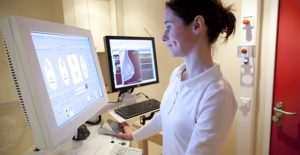Breast Cancer Treatments

Though there is no definitive cure for breast cancer, there are many different treatment options that are usually successful. The type of breast cancer treatment recommended for you will depend on the size of your tumor and the extent of the spread of the disease throughout the body.
Age, menstrual status, underlying health issues, and personal preferences also play a role in this decision-making process as well.
Local Breast Cancer Treatments
Breast cancer treatments are local or systemic. Local treatments options include removing or destroying the disease within the breast and surrounding regions, such as lymph nodes. There are two main local breast cancer treatment options.
The first option is surgery, either a mastectomy or lumpectomy. This option is also called breast-conserving therapy. There are multiple types of both procedures with descriptions depending mostly upon the depth of tissue removal.
The second option is radiation therapy, though this mostly occurs in conjunction with surgery. Most commonly, doctors prescribe radiation on cancerous cells that still appear following mastectomies or lumpectomies. Within this treatment option are two forms of breast cancer radiation: external and internal. External breast cancer radiation is the most common and is similar in process to a traditional x-ray. Internal breast cancer radiation is less common. Surgeons insert catheters of radioactive fluid nearest the cancerous cells.
Systemic Breast Cancer Treatments
Systemic treatments destroy or control cancer cells all over the body and include chemotherapy, the use of drugs to kill cancer cells. Side effects can include nausea, hair loss, early menopause, hot flashes, fatigue, and temporarily lowered blood counts.
Hormone therapy is also used in premenopausal and postmenopausal. Hormone therapy uses drugs to prevent hormones, especially estrogen, from promoting the growth of breast cancer cells that may remain after breast cancer surgery. Side effects can include hot flashes and vaginal dryness. Biological therapy works by using the body's immune system to destroy cancer cells. Systemic therapy may be given after local treatment or before). You may have just one form of breast cancer treatment or a combination of treatments, depending on your needs.
Breast Reconstruction
Patients who opt for a total mastectomy may use reconstructive surgery at the time of the mastectomy or at some subsequent time. Inserting an artificial implant below the muscle restores breast contour. If surgeons use a saline implant, they may also insert a tissue expander beneath the pectoral muscle. Saline is injected into the expander to stretch the tissues for a period of weeks or months until the desired volume is obtained. The tissue expander is then replaced by a permanent implant.
Following breast reconstruction, the chest region receives radiation therapy if the local disease recurs. Radiation therapy following reconstruction with a breast prosthesis may affect a subsequent look of the reconstructed breast.








